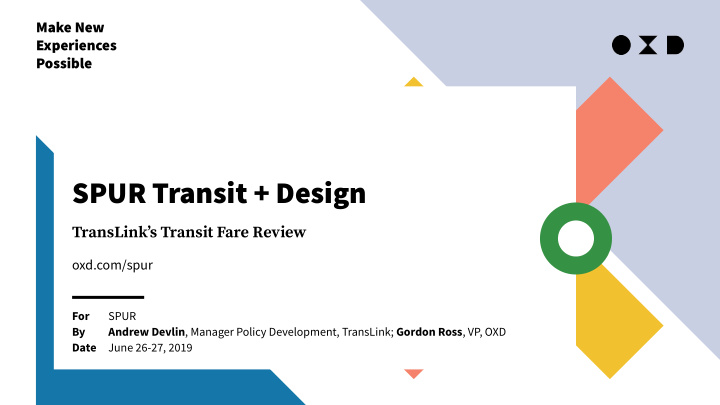



Make New Experiences Possible SPUR Transit + Design TransLink’s Transit Fare Review oxd.com/spur For SPUR By Andrew Devlin , Manager Policy Development, TransLink; Gordon Ross , VP, OXD Date June 26-27, 2019
SPUR / Transit + Design Hi, we’re Andrew and Gord!
Agenda Today’s session 1. Introductions 2. TransLink and the Transit Fare Review 3. Design for Policy 4. Reflections and lessons learned 5. Discussion 3
Introducing Translink 4
About Translink TransLink is Metro Vancouver’s regional transit and transportation authority. Every day we move over 400,000 people on our transit system. 5
7
About Translink TransLink, by the numbers $2.0 billion operating budget, ● $5.0 billion assets $500 million fare revenue ● 7,000 employees ● 1,800 km sq service area ● (695 miles sq) 21 municipalities ● 436 million boardings per year ● (7.1% increase in 2018) 8
And introducing OXD 9
About OXD OXD is an end-to-end design and technology consulting firm. We work with complex organizations to build up their internal capabilities while bringing new digital products and services to life. 10
About OXD We’ve helped industry leaders design for—and with—their customers to build digital services that people love to use. 11
The Transit Fare Review
Transit Fare Review The problem Current fare structure largely unchanged since the mid 1980’s and was perceived as unfair, inflexible, and not reflective of how people travel. 13
Transit Fare Review The opportunity New possibilities to move towards a fare system that can work better for more people with Compass smartcard payment system. 14
Transit Fare Review We wanted to review all the ways we price transit Distance Travelled Service Type Time of Day The price you pay depending The price you pay depending on The price you pay depending on how far you travel what mode of transit you use on what time of day you travel Fare Products Discounts Transfer Time The type of ticket or pass you The reduced fares available How many minutes you purchase based on frequency to riders based on defined can travel on a single fare of travel eligibility criteria 15
Transit Fare Review Goal of the review Explore changes to the fare structure that promotes exceptional customer experience where paying for transit… ● Is simple ● Helps improve service by ● Is fair reducing overcrowding ● Is affordable ● Maintains revenue from ● Helps grow ridership fares to help pay for service 16
17
Transit Fare Review Complex policy problems require many tools Modelling and Best practices Broad engagement User experience Structured decision analysis to and industry and consultation to research and making to ensure a understand revenue trends to solicit input at every prototyping to “test defensible, rigorous and ridership impacts understand step of the process drive” policy options, and transparent what’s worked learn and iterate process elsewhere (or not) and why 18
Transit Fare Review How did we make use of user experience research and prototyping? Understand pain/pinch points in ways you can’t do through static ● surveys alone. Refine our options ; what looks good on paper or in a model might ● have fatal flaws in a real world application. Bring first-hand insight to technical analysis in order to have a ● more comprehensive suite of information to make decisions on 19
Transit Fare Review Where did we land? A balance between transformative and incremental changes. Move from zone system to ● distance-based/pay by station system Keep prepaid passes, but increase ● choice and options Expand time of day pricing ● structure Work with partners to deliver ● expanded discounts for low-income riders 20
Design for Policy 21
Product Service
Design for Policy Services: what products are not Typically intangible, having no physical form, distributed in ● space and time Cannot be owned; artifacts involved in delivering are owned ● Cannot be stored or perish ● Consumed as they are produced and sold ● Customer needs to be present for service to be delivered ● Highly varied: banking, eating at a restaurant, taking the bus ● Economically dominant; 80% of USA’s GDP (70% Canada) ● Source: Lucy Kimbell, Service Innovation Handbook 23
Source: Jamin Hegeman, VP, Capital One Design, Designing for Multi-Touchpoint Experiences 24
Design for Policy The value of Design for Policy 1. Different approaches to understanding the public’s problems 2. Co-design and collaboration with stakeholders in policy options 3. Devices that can give form to policy in practice 26
27
28
Prototyping policy? 33
Options for varying fares by distance travelled 34
Reflections 38
Reflections Andrew’s takeaways ● New tools need time to socialize and demonstrate value ● Design works best when paired with other methods ● Design is best applied as early as possible 39
Reflections Gord’s takeaways ● Qualitative methods in a quantitative world: explanation does not mean prediction ● How do we negotiate preference, explanation, and usage when understanding policy options? ● Without a service, does policy exist? 40
Make New Experiences Possible Thank you oxd.com/spur Gordon Ross , Vice President and Partner, OXD 210-12 Water Street, Vancouver, BC V6B 1A5 gordonr@oxd.com +1 604 694 0554 x103 oxd.com
Recommend
More recommend